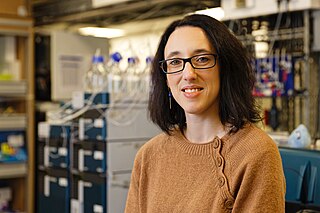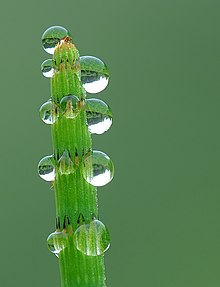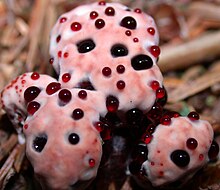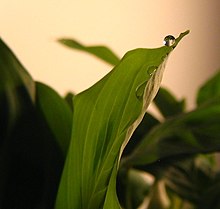
Xylem is one of the two types of transport tissue in vascular plants, the other being phloem. The basic function of the xylem is to transport water from roots to stems and leaves, but it also transports nutrients. The word xylem is derived from the Ancient Greek word ξύλον (xylon), meaning "wood"; the best-known xylem tissue is wood, though it is found throughout a plant. The term was introduced by Carl Nägeli in 1858.

Insecticides are pesticides used to kill insects. They include ovicides and larvicides used against insect eggs and larvae, respectively. Acaricides, which kill mites and ticks, are not strictly insecticides, but are usually classified together with insecticides. The major use of Insecticides is agriculture, but they are also used in home and garden, industrial buildings, vector control and control of insect parasites of animals and humans. Insecticides are claimed to be a major factor behind the increase in the 20th-century's agricultural productivity. Nearly all insecticides have the potential to significantly alter ecosystems; many are toxic to humans and/or animals; some become concentrated as they spread along the food chain.

Root pressure is the transverse osmotic pressure within the cells of a root system that causes sap to rise through a plant stem to the leaves.

Germination is the process by which an organism grows from a seed or spore. The term is applied to the sprouting of a seedling from a seed of an angiosperm or gymnosperm, the growth of a sporeling from a spore, such as the spores of fungi, ferns, bacteria, and the growth of the pollen tube from the pollen grain of a seed plant.

Excretion is a process in which metabolic waste is eliminated from an organism. In vertebrates, this is primarily carried out by the lungs, kidneys, and skin. This is in contrast with secretion, where the substance may have specific tasks after leaving the cell. Excretion is an essential process in all forms of life. For example, in placental mammals, urine is expelled through the urethra, which is part of the excretory system. In unicellular organisms, waste products are discharged directly through the surface of the cell.

Imidacloprid is a systemic insecticide belonging to a class of chemicals called the neonicotinoids which act on the central nervous system of insects. The chemical works by interfering with the transmission of stimuli in the insect nervous system. Specifically, it causes a blockage of the nicotinergic neuronal pathway. By blocking nicotinic acetylcholine receptors, imidacloprid prevents acetylcholine from transmitting impulses between nerves, resulting in the insect's paralysis and eventual death. It is effective on contact and via stomach action. Because imidacloprid binds much more strongly to insect neuron receptors than to mammal neuron receptors, this insecticide is more toxic to insects than to mammals.
Pesticides vary in their effects on bees. Contact pesticides are usually sprayed on plants and can kill bees when they crawl over sprayed surfaces of plants or other areas around it. Systemic pesticides, on the other hand, are usually incorporated into the soil or onto seeds and move up into the stem, leaves, nectar, and pollen of plants.

Ziziphus mauritiana, also known as Indian jujube, Indian plum, Chinese date, Chinese apple, ber and dunks is a tropical fruit tree species belonging to the family Rhamnaceae. It is often confused with the closely related Chinese jujube, but whereas Z. jujuba prefers temperate climates, Z. mauritiana is tropical to subtropical.
In agriculture and gardening, a beneficial organism is any organism that benefits the growing process, including insects, arachnids, other animals, plants, bacteria, fungi, viruses, and nematodes. Benefits include pest control, pollination, and maintenance of soil health. The opposite of beneficial organisms are pests, which are organisms deemed detrimental to the growing process. There are many different types of beneficial organisms as well as beneficial microorganisms. Also, microorganisms have things like salt and sugar in them. Beneficial organisms include but are not limited to: Birds, Bears, Nematodes, Insects, Arachnids, and fungi. The ways that birds and bears are considered beneficial is mainly because they consume seeds from plant and spread them through feces. Birds also prey on certain insects that eat plants and hinder them from growing these insects are known as non beneficial organisms. Nematodes are considered beneficial because they will help compost and provide nutrients for the soil the plants are growing in. Insects and arachnids help the growing process because they prey on non beneficial organisms that consume plants for food. Fungi help the growing process by using long threads of mycelium that can reach very long distances away from the tree or plant and bring water and nutrients back to the tree or plant roots.
In biology, a propagule is any material that functions in propagating an organism to the next stage in its life cycle, such as by dispersal. The propagule is usually distinct in form from the parent organism. Propagules are produced by organisms such as plants, fungi, and bacteria.
Neonicotinoids are a class of neuro-active insecticides chemically similar to nicotine, developed by scientists at Shell and Bayer in the 1980s.

Nitenpyram is a chemical frequently used as an insecticide in agriculture and veterinary medicine. The compound is an insect neurotoxin belonging to the class of neonicotinoids which works by blocking neural signaling of the central nervous system. It does so by binding irreversibly to the nicotinic acetylcholine receptor (nACHr) causing a stop of the flow of ions in the postsynaptic membrane of neurons leading to paralysis and death. Nitenpyram is highly selective towards the variation of the nACHr which insects possess, and has seen extensive use in targeted, insecticide applications.

Pesticide application refers to the practical way in which pesticides are delivered to their biological targets. Public concern about the use of pesticides has highlighted the need to make this process as efficient as possible, in order to minimise their release into the environment and human exposure. The practice of pest management by the rational application of pesticides is supremely multi-disciplinary, combining many aspects of biology and chemistry with: agronomy, engineering, meteorology, socio-economics and public health, together with newer disciplines such as biotechnology and information science.

Clothianidin is an insecticide developed by Takeda Chemical Industries and Bayer AG. Similar to thiamethoxam and imidacloprid, it is a neonicotinoid. Neonicotinoids are a class of insecticides that are chemically similar to nicotine, which has been used as a pesticide since the late 1700s. Clothianidin and other neonicotinoids act on the central nervous system of insects as an agonist of nAChR, the same receptor as acetylcholine, the neurotransmitter that stimulates and activating post-synaptic acetylcholine receptors but not inhibiting AChE. Clothianidin and other neonicotinoids were developed to last longer than nicotine, which is more toxic and which breaks down too quickly in the environment.
A xerophyte is a species of plant that has adaptations to survive in an environment with little liquid water. Examples of xerophytes include cacti, pineapple and some gymnosperm plants. The morphology and physiology of xerophytes are adapted to conserve water during dry periods. Some species called resurrection plants can survive long periods of extreme dryness or desiccation of their tissues, during which their metabolic activity may effectively shut down. Plants with such morphological and physiological adaptations are said to be xeromorphic. Xerophytes such as cacti are capable of withstanding extended periods of dry conditions as they have deep-spreading roots and capacity to store water. Their waxy, thorny leaves prevent loss of moisture.
Hydraulic redistribution is a passive mechanism where water is transported from moist to dry soils via subterranean networks. It occurs in vascular plants that commonly have roots in both wet and dry soils, especially plants with both taproots that grow vertically down to the water table, and lateral roots that sit close to the surface. In the late 1980s, there was a movement to understand the full extent of these subterranean networks. Since then it was found that vascular plants are assisted by fungal networks which grow on the root system to promote water redistribution.

Acetamiprid is an organic compound with the chemical formula C10H11ClN4. It is an odorless neonicotinoid insecticide produced under the trade names Assail, and Chipco by Aventis CropSciences. It is systemic and intended to control sucking insects (Thysanoptera, Hemiptera, mainly aphids) on crops such as leafy vegetables, citrus fruits, pome fruits, grapes, cotton, cole crops, and ornamental plants. It is also a key pesticide in commercial cherry farming due to its effectiveness against the larvae of the cherry fruit fly.

Thiamethoxam is the ISO common name for a mixture of cis-trans isomers used as a systemic insecticide of the neonicotinoid class. It has a broad spectrum of activity against many types of insects and can be used as a seed dressing.
Plant root exudates are fluids emitted through the roots of plants. These secretions influence the rhizosphere around the roots to inhibit harmful microbes and promote the growth of self and kin plants.

Chiara Giorio is an Italian atmospheric chemist who is an Assistant Professor in the Yusuf Hamied Department of Chemistry at the University of Cambridge, a Fellow of Christ's College and a Fellow of the Community for Analytical Measurement Science.
















